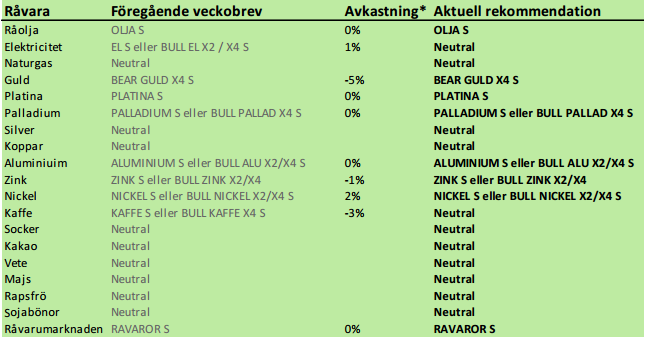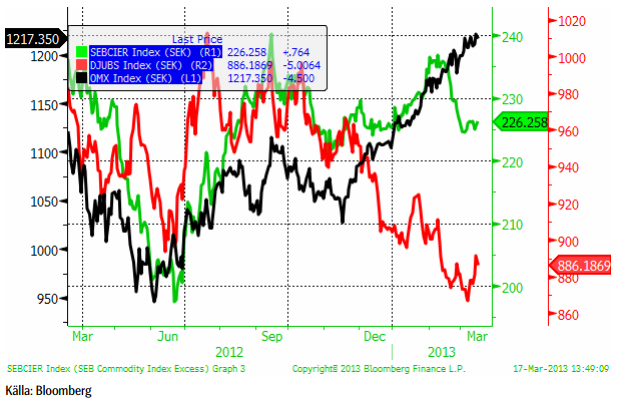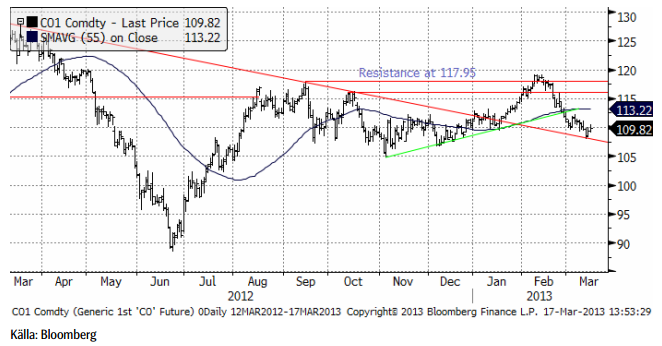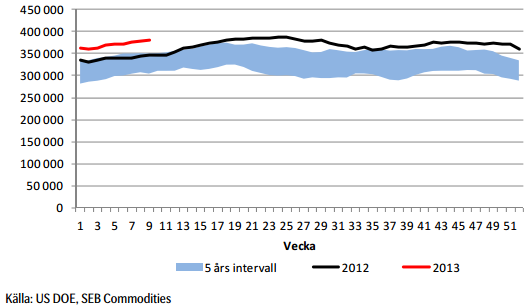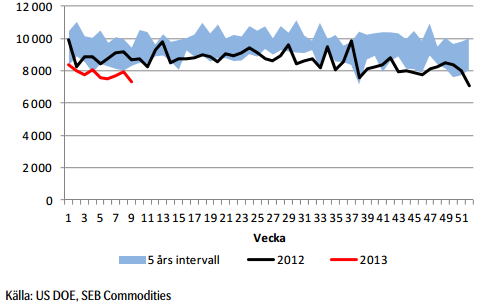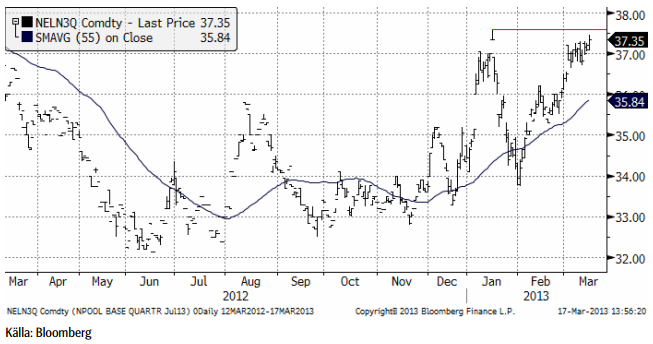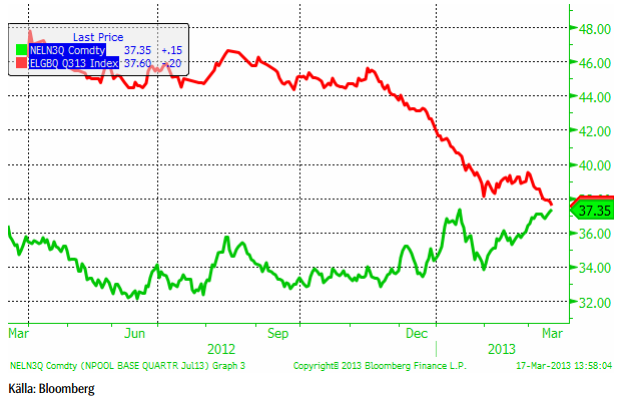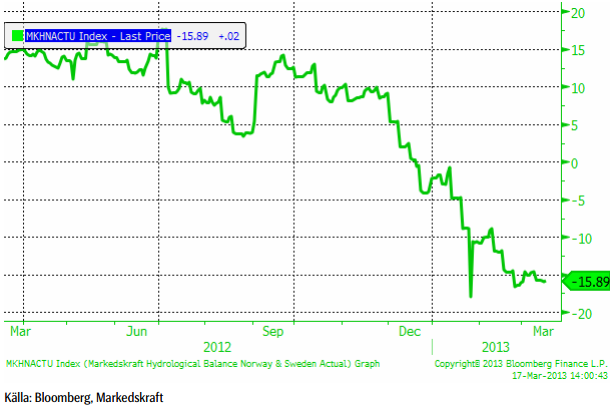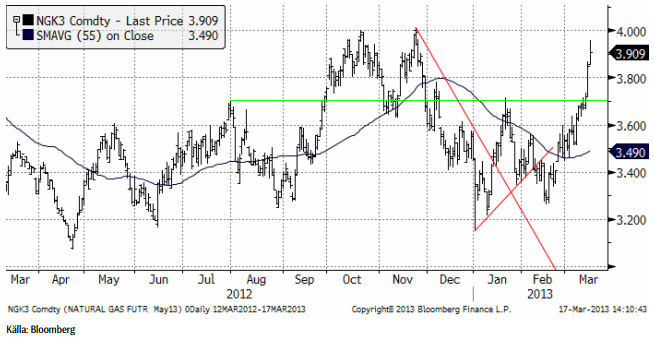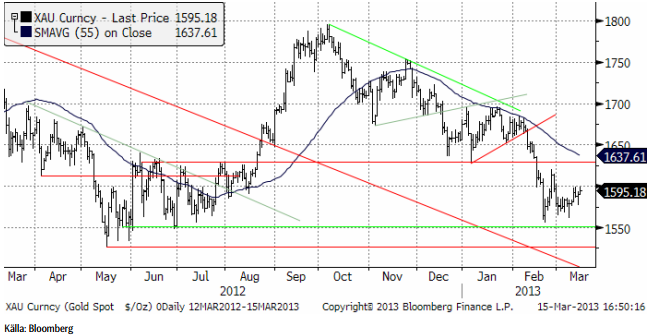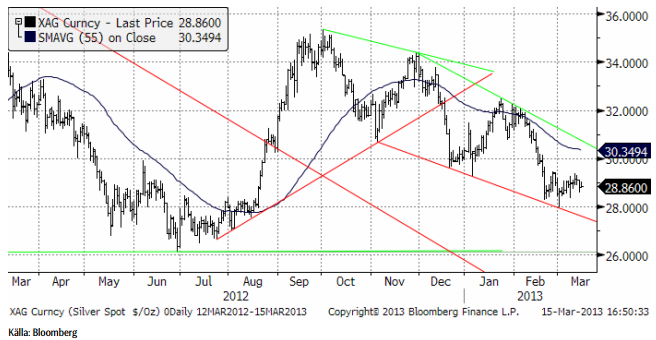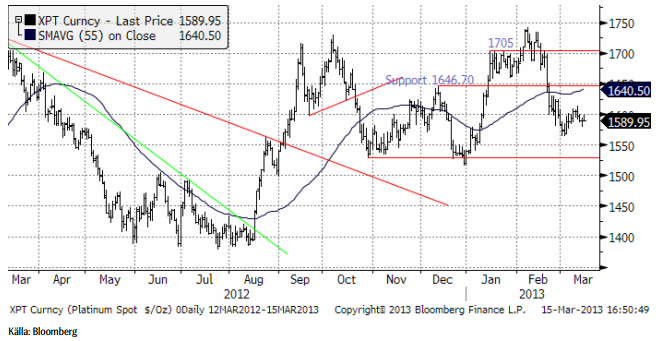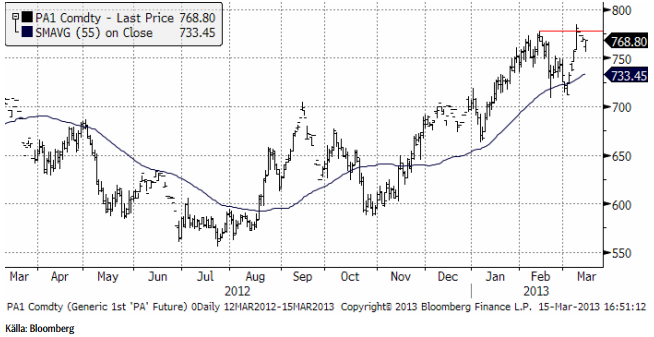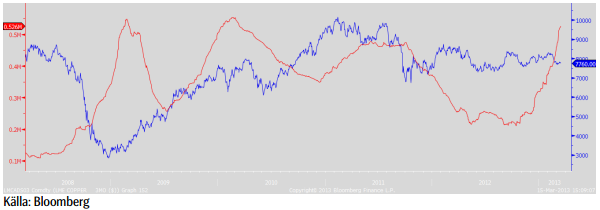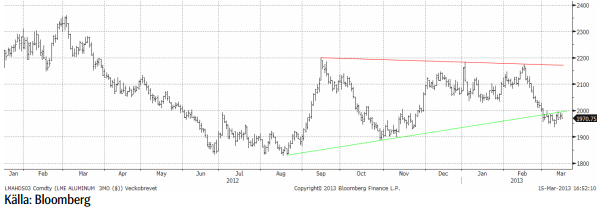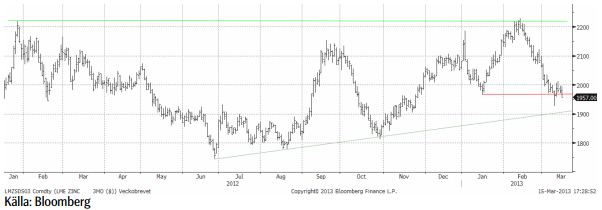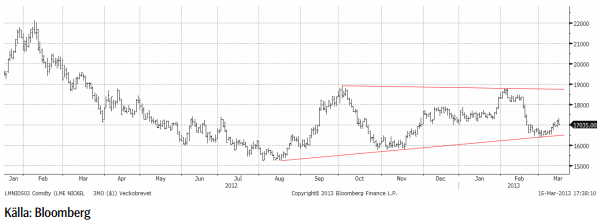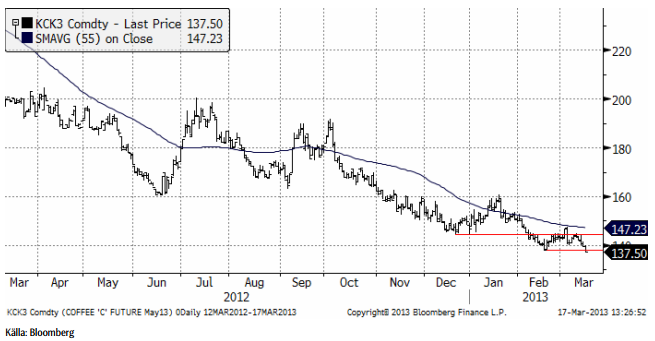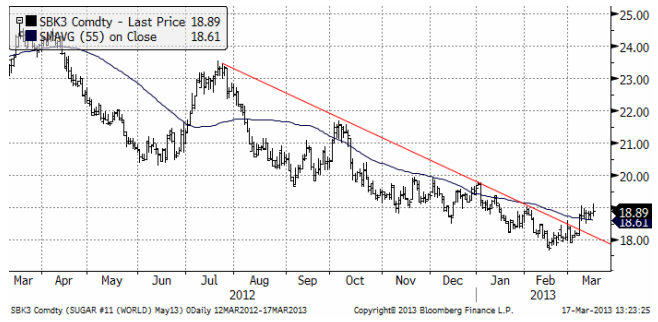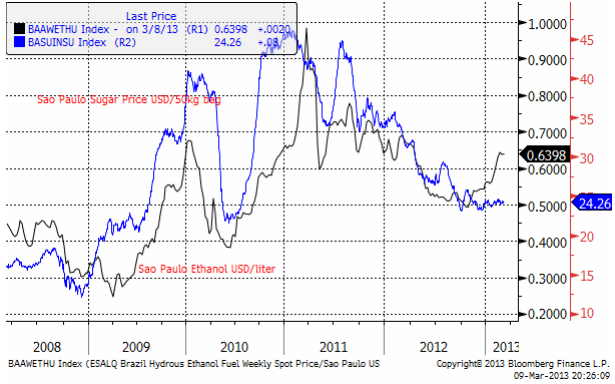Analys
SEB – Råvarukommentarer, 18 mars 2013

Rekommendationer
*) Avkastningen avser 1:1 råvarucertifikat där de ingår i rekommendationen. I den aktuella tabellen ovan har jag tagit prisförändringen den senaste veckan sedan det förra veckobrevet publicerades.
Inledning
Råvarumarknaden var ganska lugn och avvaktande förra veckan. Flera råvarumarknader har avslutat (?) en större prisrörelse och befinner sig i rekyl mot den tidigare trenden, som t ex majs, vete, ädelmetaller. Andra börjar närma sig psykologiskt viktiga nivåer, som t ex elektriciteten.
Den här veckan gör vi ett par ändringar av vår vy. Trots att det mesta fundamentalt pekar på att kaffepriset är lågt och borde kunna ligga högre går vi över till neutral rekommendation. Elmarknaden som vi haft köpt rekommendation på i flera månader väljer vi nu att också gå över till neutral rekommendation på. Priset börjar närma sig tidigare toppnotering och det tyska priset har fortsatt att falla.
Råvaruindex
I diagrammet nedan ser vi SEB:s råvaruindex (grön), OMX (svart) och DJUBS (röd), alla omräknade till svenska kronor. Vi ser att DJ UBS drabbats mycket av dess stora övervikt på jordbruksprodukter. SEB:s index har drabbats av detta också, men inte i lika stor utsträckning. Prisfallet på energi den senaste månaden har däremot tyngt indexet. Aktier har gått starkt sedan november. Den senaste månaden har råvaruindex sjunkit och aktier stigit.
Den som vill investera i indexet och den investeringsstrategi som ligger bakom kan läsa mer certifikatet RAVAROR S.
Råolja – Brent
Oljepriset har fortsatt att falla. I bankens senaste Oil Market report varnas för att den här svagheten kan komma att fortsätta
Lagren och lagerförändringarna i USA per den 8 mars ser vi nedan, enligt Department of Energy och American Petroleum Institute.
Nedan ser vi amerikanska råoljelager enligt DOE i tusen fat. Den svarta kurvan är 2012 års lagernivåer vecka för vecka och den lilla röda linjen är 2013 års nivå. Vi ser att lagernivåerna fortsätter att vara högre än de varit sedan 2007 för den här tiden på året.
Lagren ökar samtidigt som vi ser att importen av råolja till USA fortsätter att minska. I veckans statistik minskade importtakten ytterligare.
Vi rekommenderar köp av OLJA S, men inte av BULL OLJA S. Anledningen till denna skillnad och att vi rekommenderar köp av OLJA S är för att rabatten på terminerna innebär en stadig intäkt om ca 6% till 7% per år + ränta på kapitalet.
Elektricitet
Underliggande för SEB:s certifikat på el är det tredje kvartalets terminskontrakt. Det avser alltså vad det genomsnittliga spotpriset kommer att bli under juli, augusti och september. Vi ser kursdiagrammet för det senaste året nedan.
Nedanför ser vi prisutvecklingen för det tredje kvartalets tyska elpriskontrakt (röd) och Nord Pools tredje kvartalskontrakt (grön). Det tyska priset har fortsatt att falla och det nordiska att stiga. Det är nu bara 25 eurocent som skiljer priserna åt.
Det är en kall och torr vår gör sommaren kort, skrev Lars Wivallius år 1642. Den hydrologiska balansen för Nord Pools börsområde har sjunkit ytterligare från -14.66 TWh till -15.89 TWh.
Sammanfattningsvis. En lite otydlig situation. Priset för tredje kvartalet börjar närma sig den föregående toppen vid 37.60. Det brukar kunna locka fram säljordrar. Att det tyska priset samtidigt fortsätt att falla är också ett negativt tecken. Att priset på el skulle vara högre i vattenkraftsrika Norden än i Tyskland hör till ovanligheterna även om det förekommit. Det är svårt att rekommendera köp just nu, så vi går över till neutral i avvaktan på att se om priset tar ut toppen på 37.60.
Naturgas
Naturgasterminen på NYMEX (maj 2013) har handlats upp ordentligt och närmar sig 4 dollar, där priset vänt ner två gånger tidigare. Vi fortsätter att hålla oss neutralt till naturgasen.
Guld & Silver
Guldpriset rekylerade upp i veckan som gick. Frågan är nu om den senaste månadens konsolidering kommer att följas av ytterligare prisfall – förbi 1550 eller om marknaden kommer att söka över 1600 och upp mot 1650?
Situationen liknar den från 2008/09, när placerare sålde guld och köpte aktier. Vi har stora utflöden ur fonder med fysiskt guld. Samtidigt verkar guld bli mer populärt bland centralbanker. I veckan kom uppgifter om att den japanska centralbanken ska köpa mer guld. Det har i och för sig inte entydigt ett positivt signalvärde. Centralbanker storsålde under hela 70-talets guldprisuppgång. När de blev nettoköpare på 80-talet var boomen förbi. Konservativa och följande organisationer ligger alltså sent i cykeln – kanske så sent att de blir något av kontraindikatorer.
Nedan ser vi kursdiagrammet för silver i dollar per troy ounce. Även här har priset rört sig ”sidledes” den senaste månaden och bygger upp fallhöjd om priset ska följa den inslagna trenden nedåt.
Platina & Palladium
Den sydafrikanska randen föll till nya bottennivåer mot dollarn i veckan som gick. Det ökar lönsamheten för de pressade gruvbolagen och tynger därmed priset på platina.
Palladium som rusade förrförra veckan, har konsoliderat sin uppgång. Det är förmodligen ingen dum idé att köpa palladium nu.
Koppar
Kopparpriset stabiliserades i veckan och noteras i skrivandes stund ca 1 % högre från veckostarten. Vi har i de senaste veckobreven uttryckt en viss försiktighet gentemot koppar med hänvisning till ett förväntat skifte, från en ”kronisk” marknad i underskott, till mer balanserad. En del tecken tyder på att utbudet nu verkligen ökar. Vi har poängterad en ökad contango (terminspremie) på de närmsta terminerna, ökade smältlöner (till förmån för smältverken, vilket indikerar ökat gruvutbud). LME-lagret är en annan indikation (se grafen nedan) som nu uppgår till 525 tton, den högsta nivån på nästa 3 år. Lagerförändringarna samvarierar ganska väl med importen till Kina (som vi skrev om förra veckan), vilket således också är en negativ indikation.
Koppar pris/lager (pris blå linje/LME-lager röd linje)
Den tekniska bilden ger stöd till vår neutrala position. Vi är positiva till basmetaller på sikt men avvaktar bättre köptillfällen på koppar, alternativt väljer någon annan basmetall. Den stora triangelformationen börjar spela ut sin roll. Stödnivåer noteras vid 7600 och 7400. Nivån 7800 fungerar nu som motstånd.
Vi ser inte den stora potentialen på koppar på uppsidan just nu. Vi rekommenderar därför en fortsatt neutral position. För den som vill satsa på ett starkare tillväxtscenario (än konsensus) i Kina är koppar däremot alltid ett intressant alternativ.
Aluminium
Aluminiumpriset har till stor del följt kopparn under veckan, som avslutas med en positiv veckoförändring på ca 1 %. Som vi skrivit tidigare ligger aluminium väldigt ”fast” i ett relativt stort handelsintervall. Nivåer kring $1800-1900 utgör ur ett kostnadsperspektiv starkt stöd. Samtidigt lägger det stora utbudet ett ”tak” på nivåer kring $2300. Den senaste uppgången i februari mötte stora säljordrar från producenter som passade på att ”låsa” framtida priser, vilket satte press på marknaden. Nu när priserna fallit tillbaka ser vi stora intressen från köpsidan (fysiska förbrukare). För den ”trading-benägne” utgör det stora spannet goda vinstmöjligheter.
P.g.a. den låga prisnivån i relation till marginalkostnaden är aluminium köpvärd och vi ansluter den till köprekommendationerna.
Zink
Även zinken återhämtade sig med övriga basmetaller under veckans inledning men slutar veckan i princip oförändrad. Tekniska fonder har varit säljare och tryckt tillbaka marknaden vid varje återhämtningsförsök. Priset är nu nere på nivåer då marknaden bör få stöd av förväntningar om minskat utbud. Priset skär ned i kostnadskurvan och producenterna med de högsta kostnaderna förväntas minska produktionen om priserna ligger kvar under en lägre tid. Frågan är hur lång tid det tar. Vid tidigare nedgångar har marknaden börjat diskontera utbudseffekten vilket ger stöd till priset.
Tekniskt sett ser det svagt ut just nu och det finns risk för fortsatt press från tekniskt orienterade fonder. Det långsiktiga stödet kommer in kring $1900.
Placeringsförslaget från december med horisonten 3 månader kan summeras med en god utveckling inledningsvis. Under perioden steg priset till som högst $2250 (3 månaders LME). Vi är generellt positiva till basmetaller och återkommer eventuellt med ett nytt placeringsförslag på zink längre fram. Nu håller vi oss neutrala, och avvaktar i första hand utvecklingen nästa vecka.
Nickel
Efter den stora tillbakagången ser vi en tydlig stabilisering av priset. Ur ett kostnadsperspektiv börjar nickel bli en väldigt intressant köpkandidat. Marknaden är fortsatt tveksam till den fundamentala situationen. Vi har tidigare bl.a. hänvisat till kommentarer från fysiska aktörer som indikerar att ”det finns gott om nickel”, samtidigt som rapporter gör gällande att exporten av nickelmalm från Indonesien till Kina ökar igen, vilket riskerar att öka utbudet av s.k. Nickel Pig Iron i Kina (vilket i sin tur minskar efterfrågan på nickelbärande skrot och primärnickel). Det senare håller nu på att ”svänga om” då kinesiska producenter är snabba att ställa om produktionen. Det ger ett naturligt stöd till nickelmarknaden. Den tekniska bilden är väldigt tydlig, och marknaden vände ”där den skulle”. Priset är upp ca 3 % i veckan. Kortsiktigt finns risk/möjlighet för en tillbakagång. Om priset kommer ned mot $16500 igen är det köpläge.
Vi rekommenderar köp av NICKEL S eller BULL NICKEL X2 / X4 S för den som vill ta mer risk. Vi varnade för en rekyl, och den kom. Priset har fallit mer än ”befarat”, men är nu på väldigt attraktiva nivåer.
Kaffe
Kaffepriset (maj 2013) bröt i fredags innan stängning under det tekniska stödet och stängde på 137.50 cent per pund. Den fallande trenden har alltså liksom vintern i Sverige, ännu övertaget. Många har liksom jag trott att priset skulle vända upp snabbare. Kortsiktigt kan de som tar sig ur positionerna för att inte små förluster ska utveckla sig till större, få priset att falla ytterligare. På längre sikt ”borde” priset finna en botten snart och handla högre. Osäkerheten gäller mer tajmingen på den botten.
Vi går därmed över till neutral rekommendation på kaffe, eftersom vi befarar att det kan bli ytterligare prisnedgångar på kort sikt.
Socker
Sockerpriset (maj 2013) som brutit den nedåtgående trenden rent tekniskt fortsätter att testa 19 cent. I fredags försökte marknaden handla upp priset, men när dagen var slut stängde priset på 18.89 cent per pund. Vi har tidigare skrivit att priset på etanol i Brasilien har gått upp – vilket drar med sig priset på socker. Under majs (nedan) ser vi också att priset på etanol i USA har stigit stadigt, vilket är en faktor bakom stödet för majspriset. Det är också en stödjande faktor för sockerpriset.
Brasiliens regering vill öka användningen av etanol som drivmedel i landet. Många bilar i landet går att köra på både bensin och etanol, men priserna har varit sådana att folk har valt att tanka med bensin. Den ökade fokuseringen på etanol har fått priset att stiga, som vi ser i nedanstående diagram, som visar etanolpriset i Sao Paulo i USD per liter. Den blå linjen är priset på socker i samma delstat.
Vi ser att de två linjerna tenderar att hänga ihop och en uppgång i priset på etanol kan signalera att priset på socker också kommer att stiga framöver.
Finns tecken på att priset på socker är nära botten, men än så länge är pristrenden så stark att vi väljer att behålla neutral rekommendation ytterligare en vecka.
Vi tror att en trendvändning kan vara på gång. Prisuppgången till 19 cent, ett motstånd, är ett observandum.
[box]SEB Veckobrev Veckans råvarukommentar är producerat av SEB Merchant Banking och publiceras i samarbete och med tillstånd på Råvarumarknaden.se[/box]
Disclaimer
The information in this document has been compiled by SEB Merchant Banking, a division within Skandinaviska Enskilda Banken AB (publ) (“SEB”).
Opinions contained in this report represent the bank’s present opinion only and are subject to change without notice. All information contained in this report has been compiled in good faith from sources believed to be reliable. However, no representation or warranty, expressed or implied, is made with respect to the completeness or accuracy of its contents and the information is not to be relied upon as authoritative. Anyone considering taking actions based upon the content of this document is urged to base his or her investment decisions upon such investigations as he or she deems necessary. This document is being provided as information only, and no specific actions are being solicited as a result of it; to the extent permitted by law, no liability whatsoever is accepted for any direct or consequential loss arising from use of this document or its contents.
About SEB
SEB is a public company incorporated in Stockholm, Sweden, with limited liability. It is a participant at major Nordic and other European Regulated Markets and Multilateral Trading Facilities (as well as some non-European equivalent markets) for trading in financial instruments, such as markets operated by NASDAQ OMX, NYSE Euronext, London Stock Exchange, Deutsche Börse, Swiss Exchanges, Turquoise and Chi-X. SEB is authorized and regulated by Finansinspektionen in Sweden; it is authorized and subject to limited regulation by the Financial Services Authority for the conduct of designated investment business in the UK, and is subject to the provisions of relevant regulators in all other jurisdictions where SEB conducts operations. SEB Merchant Banking. All rights reserved.
Analys
Brent crude ticks higher on tension, but market structure stays soft

Brent crude has climbed roughly USD 1.5-2 per barrel since Friday, yet falling USD 0.3 per barrel this mornig and currently trading near USD 67.25/bbl after yesterday’s climb. While the rally reflects short-term geopolitical tension, price action has been choppy, and crude remains locked in a broader range – caught between supply-side pressure and spot resilience.

Prices have been supported by renewed Ukrainian drone strikes targeting Russian infrastructure. Over the weekend, falling debris triggered a fire at the 20mtpa Kirishi refinery, following last week’s attack on the key Primorsk terminal.
Argus estimates that these attacks have halted ish 300 kbl/d of Russian refining capacity in August and September. While the market impact is limited for now, the action signals Kyiv’s growing willingness to disrupt oil flows – supporting a soft geopolitical floor under prices.
The political environment is shifting: the EU is reportedly considering sanctions on Indian and Chinese firms facilitating Russian crude flows, while the U.S. has so far held back – despite Bessent warning that any action from Washington depends on broader European participation. Senator Graham has also publicly criticized NATO members like Slovakia and Hungary for continuing Russian oil imports.
It’s worth noting that China and India remain the two largest buyers of Russian barrels since the invasion of Ukraine. While New Delhi has been hit with 50% secondary tariffs, Beijing has been spared so far.
Still, the broader supply/demand balance leans bearish. Futures markets reflect this: Brent’s prompt spread (gauge of near-term tightness) has narrowed to the current USD 0.42/bl, down from USD 0.96/bl two months ago, pointing to weakening backwardation.
This aligns with expectations for a record surplus in 2026, largely driven by the faster-than-anticipated return of OPEC+ barrels to market. OPEC+ is gathering in Vienna this week to begin revising member production capacity estimates – setting the stage for new output baselines from 2027. The group aims to agree on how to define “maximum sustainable capacity,” with a proposal expected by year-end.
While the IEA pegs OPEC+ capacity at 47.9 million barrels per day, actual output in August was only 42.4 million barrels per day. Disagreements over data and quota fairness (especially from Iraq and Nigeria) have already delayed this process. Angola even quit the group last year after being assigned a lower target than expected. It also remains unclear whether Russia and Iraq can regain earlier output levels due to infrastructure constraints.
Also, macro remains another key driver this week. A 25bp Fed rate cut is widely expected tomorrow (Wednesday), and commodities in general could benefit a potential cut.
Summing up: Brent crude continues to drift sideways, finding near-term support from geopolitics and refining strength. But with surplus building and market structure softening, the upside may remain capped.
Analys
Volatile but going nowhere. Brent crude circles USD 66 as market weighs surplus vs risk

Brent crude is essentially flat on the week, but after a volatile ride. Prices started Monday near USD 65.5/bl, climbed steadily to a mid-week high of USD 67.8/bl on Wednesday evening, before falling sharply – losing about USD 2/bl during Thursday’s session.

Brent is currently trading around USD 65.8/bl, right back where it began. The volatility reflects the market’s ongoing struggle to balance growing surplus risks against persistent geopolitical uncertainty and resilient refined product margins. Thursday’s slide snapped a three-day rally and came largely in response to a string of bearish signals, most notably from the IEA’s updated short-term outlook.
The IEA now projects record global oversupply in 2026, reinforcing concerns flagged earlier by the U.S. EIA, which already sees inventories building this quarter. The forecast comes just days after OPEC+ confirmed it will continue returning idle barrels to the market in October – albeit at a slower pace of +137,000 bl/d. While modest, the move underscores a steady push to reclaim market share and adds to supply-side pressure into year-end.
Thursday’s price drop also followed geopolitical incidences: Israeli airstrikes reportedly targeted Hamas leadership in Doha, while Russian drones crossed into Polish airspace – events that initially sent crude higher as traders covered short positions.
Yet, sentiment remains broadly cautious. Strong refining margins and low inventories at key pricing hubs like Europe continue to support the downside. Chinese stockpiling of discounted Russian barrels and tightness in refined product markets – especially diesel – are also lending support.
On the demand side, the IEA revised up its 2025 global demand growth forecast by 60,000 bl/d to 740,000 bl/d YoY, while leaving 2026 unchanged at 698,000 bl/d. Interestingly, the agency also signaled that its next long-term report could show global oil demand rising through 2050.
Meanwhile, OPEC offered a contrasting view in its latest Monthly Oil Market Report, maintaining expectations for a supply deficit both this year and next, even as its members raise output. The group kept its demand growth estimates for 2025 and 2026 unchanged at 1.29 million bl/d and 1.38 million bl/d, respectively.
We continue to watch whether the bearish supply outlook will outweigh geopolitical risk, and if Brent can continue to find support above USD 65/bl – a level increasingly seen as a soft floor for OPEC+ policy.
Analys
Waiting for the surplus while we worry about Israel and Qatar

Brent crude makes some gains as Israel’s attack on Hamas in Qatar rattles markets. Brent crude spiked to a high of USD 67.38/b yesterday as Israel made a strike on Hamas in Qatar. But it wasn’t able to hold on to that level and only closed up 0.6% in the end at USD 66.39/b. This morning it is starting on the up with a gain of 0.9% at USD 67/b. Still rattled by Israel’s attack on Hamas in Qatar yesterday. Brent is getting some help on the margin this morning with Asian equities higher and copper gaining half a percent. But the dark cloud of surplus ahead is nonetheless hanging over the market with Brent trading two dollar lower than last Tuesday.

Geopolitical risk premiums in oil rarely lasts long unless actual supply disruption kicks in. While Israel’s attack on Hamas in Qatar is shocking, the geopolitical risk lifting crude oil yesterday and this morning is unlikely to last very long as such geopolitical risk premiums usually do not last long unless real disruption kicks in.
US API data yesterday indicated a US crude and product stock build last week of 3.1 mb. The US API last evening released partial US oil inventory data indicating that US crude stocks rose 1.3 mb and middle distillates rose 1.5 mb while gasoline rose 0.3 mb. In total a bit more than 3 mb increase. US crude and product stocks usually rise around 1 mb per week this time of year. So US commercial crude and product stock rose 2 mb over the past week adjusted for the seasonal norm. Official and complete data are due today at 16:30.
A 2 mb/week seasonally adj. US stock build implies a 1 – 1.4 mb/d global surplus if it is persistent. Assume that if the global oil market is running a surplus then some 20% to 30% of that surplus ends up in US commercial inventories. A 2 mb seasonally adjusted inventory build equals 286 kb/d. Divide by 0.2 to 0.3 and we get an implied global surplus of 950 kb/d to 1430 kb/d. A 2 mb/week seasonally adjusted build in US oil inventories is close to noise unless it is a persistent pattern every week.
US IEA STEO oil report: Robust surplus ahead and Brent averaging USD 51/b in 2026. The US EIA yesterday released its monthly STEO oil report. It projected a large and persistent surplus ahead. It estimates a global surplus of 2.2 m/d from September to December this year. A 2.4 mb/d surplus in Q1-26 and an average surplus for 2026 of 1.6 mb/d resulting in an average Brent crude oil price of USD 51/b next year. And that includes an assumption where OPEC crude oil production only averages 27.8 mb/d in 2026 versus 27.0 mb/d in 2024 and 28.6 mb/d in August.
Brent will feel the bear-pressure once US/OECD stocks starts visible build. In the meanwhile the oil market sits waiting for this projected surplus to materialize in US and OECD inventories. Once they visibly starts to build on a consistent basis, then Brent crude will likely quickly lose altitude. And unless some unforeseen supply disruption kicks in, it is bound to happen.
US IEA STEO September report. In total not much different than it was in January

US IEA STEO September report. US crude oil production contracting in 2026, but NGLs still growing. Close to zero net liquids growth in total.

-

 Nyheter4 veckor sedan
Nyheter4 veckor sedanMeta bygger ett AI-datacenter på 5 GW och 2,25 GW gaskraftverk
-

 Nyheter4 veckor sedan
Nyheter4 veckor sedanAker BP gör ett av Norges största oljefynd på ett decennium, stärker resurserna i Yggdrasilområdet
-

 Nyheter4 veckor sedan
Nyheter4 veckor sedanEtt samtal om koppar, kaffe och spannmål
-

 Analys4 veckor sedan
Analys4 veckor sedanBrent sideways on sanctions and peace talks
-

 Nyheter4 veckor sedan
Nyheter4 veckor sedanSommarens torka kan ge högre elpriser i höst
-

 Analys4 veckor sedan
Analys4 veckor sedanBrent edges higher as India–Russia oil trade draws U.S. ire and Powell takes the stage at Jackson Hole
-

 Nyheter3 veckor sedan
Nyheter3 veckor sedanMahvie Minerals är verksamt i guldrikt område i Finland
-

 Analys3 veckor sedan
Analys3 veckor sedanIncreasing risk that OPEC+ will unwind the last 1.65 mb/d of cuts when they meet on 7 September


